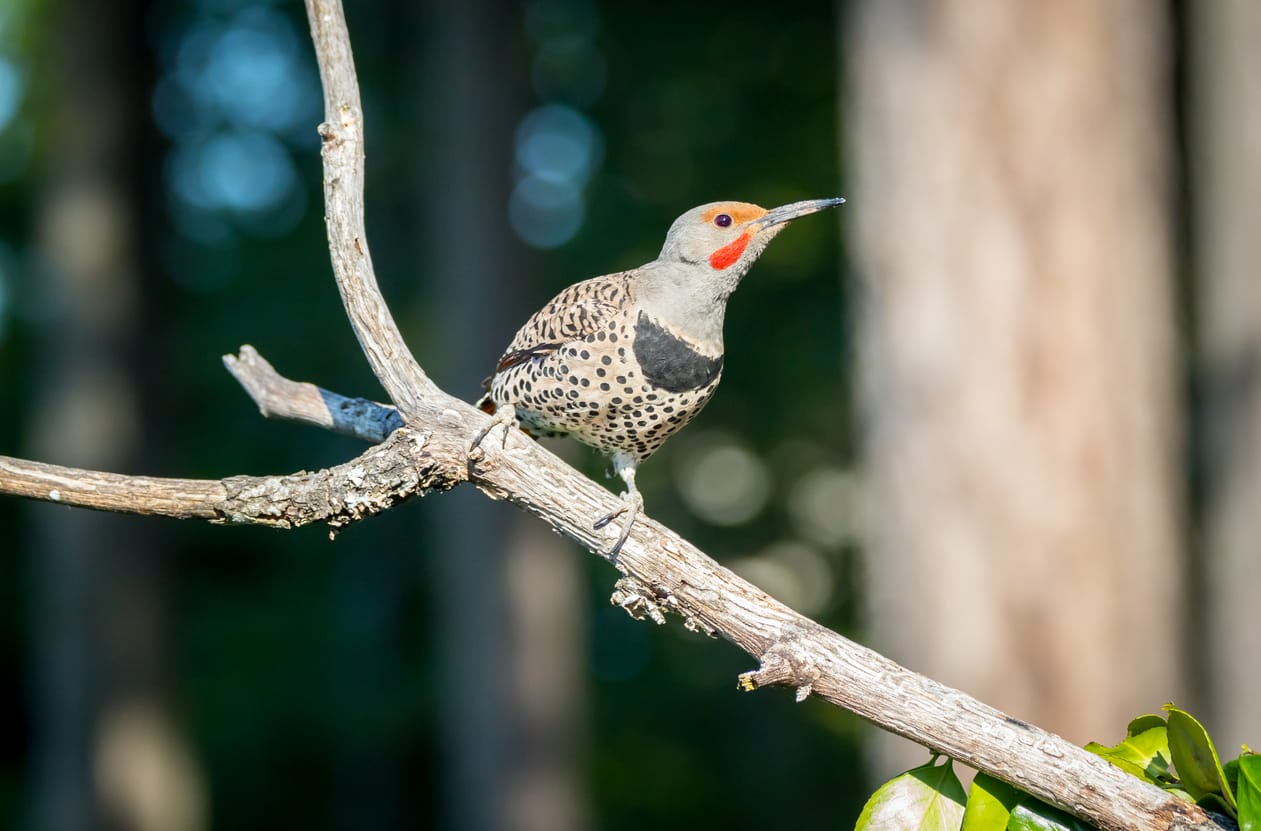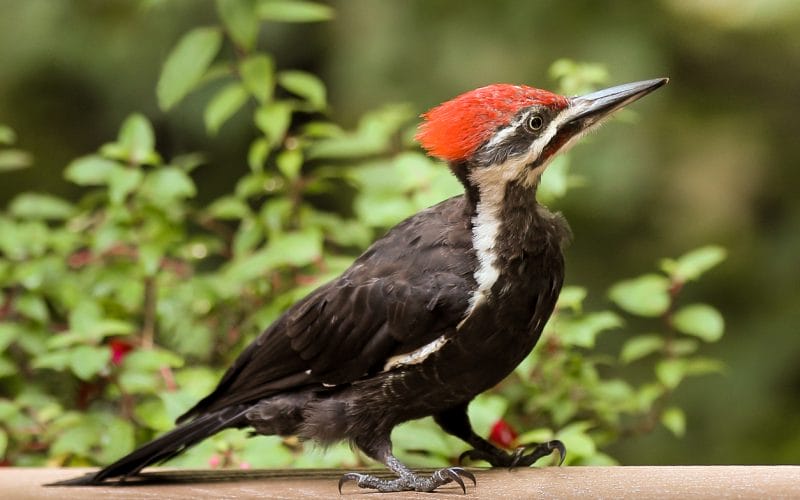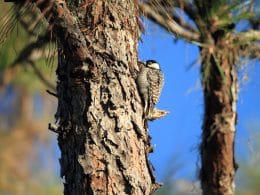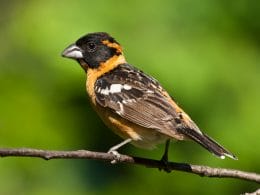Did you know that woodpeckers have their tongues wrapped around their brains? Their long tongues act as a cushion to protect their brains from injury during high-speed pecking.
Woodpeckers may look like regular birds but their fast drumming surely sets them apart. If you live in Pennsylvania and are looking forward to meeting some, then you’re in luck!
Here are seven different species of woodpeckers in Pennsylvania.
1. Northern Flicker

- Scientific name: Colaptes Auratus
- Length: 11.0-12.2 inches
- Weight: 3.9-5.6 ounces
- Wingspan: 16.5-20.1 inches
Northern Flickers are one of the most common woodpeckers that can be found all over the United States.
These woodpeckers are fairly large; slightly larger than robins. The main color scheme of Northern Flickers is a grayish or brownish body covered with black dots. The wings are often slightly darker than the body and have the same black-dotted pattern.
Author Note: Chests of Northern Flickers have black crests looking upwards, while the back of their necks has a red crest that’s also pointing up.
Eastern Flickers have the undersides of both their wings and tails colored yellow. Their Western peers have yellow undersides instead of red.
Northern Flickers breed almost all over North America. You can find them in almost any green area. They form their nests in cavities of trees but surprisingly, that’s not where you’d often find them.
Northern Flickers are ground foragers, they feed on insects and they have a special preference for ants and beetles.
That being said, don’t be surprised if you accidentally scare a Northern Flicker off the ground. It’s a common occurrence because they spend most of their time using their long curved bills to look for food.
Northern Flickers often mix their calls with their drumming or “wood pecking.” Their calls sound like rapid short chirps that increase in intensity.
Northern Flickers drum on objects as a means of communication. Sometimes, however, it’s territorial defense. The defensive drumming is often so loud and not exclusively on wood. In Wyoming, a Northern Flicker was heard drumming on a tractor from almost a half-mile distance!
2. Red-headed Woodpecker
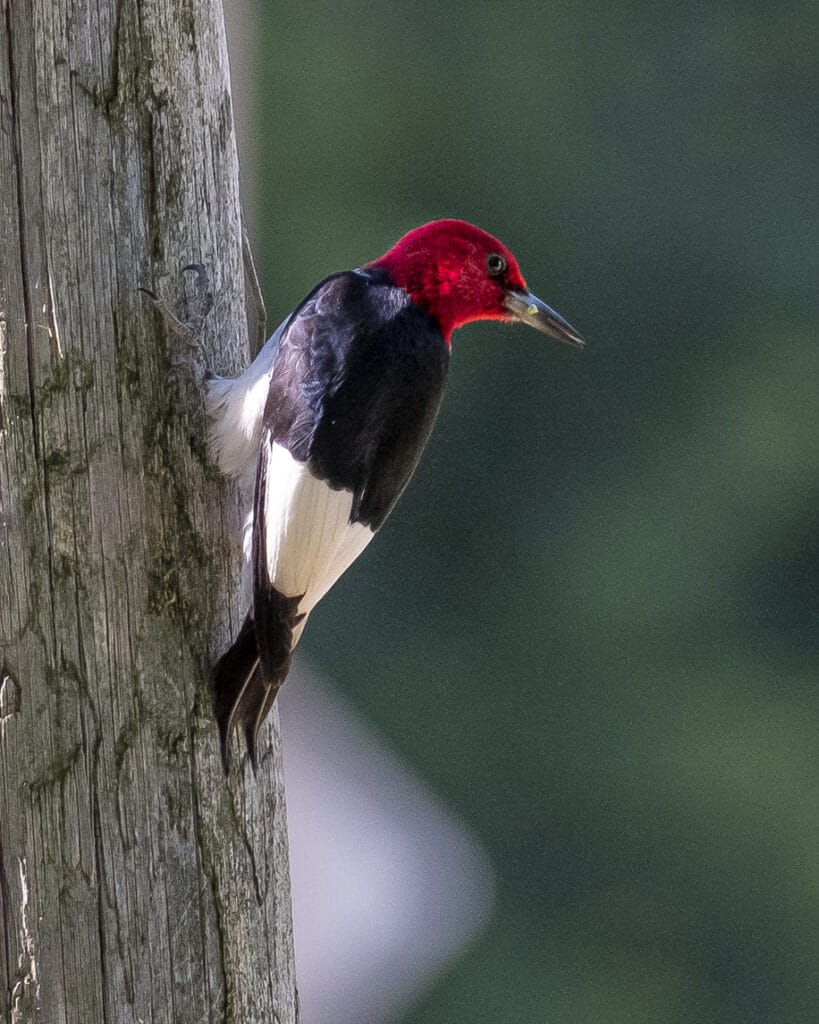
- Scientific name: Melanerpes Erythrocephalus
- Length: 7.5-9.1 inches
- Weight: 2.0-3.2 ounces
- Wingspan: 16.5 inches
Red-headed Woodpeckers, the inspiration behind the famous cartoon character Woody Woodpecker, are medium-sized birds that are slightly smaller than Northern Flickers.
The color pattern of the Red-headed Woodpecker is so bold that it’s sometimes called the “flying checkerboard.”
The Red-headed Woodpecker boasts a gorgeous red crown, a sharp short bill, a white belly, and blue and white checkered wings and tails.
What’s fascinating about this bird is that its juvenile form looks nothing like its adult form.
Red-headed Woodpecker juniors have the same white pattern as adults, but the red and blue colors are all replaced with a dark brown hue. As they mature, they start to look more like Woody Woodpecker.
If you’re a citizen of Pennsylvania, you’ve mostly come across one already. Red-headed Woodpeckers live and breed in your state. You can often see them whenever trees are around. Just like Northern Flickers, they like to build their nests in tree cavities.
However, unlike Northern Flickers, they don’t seek their food on the ground. Instead, they prefer catching flying insects mid-air. Since Red-headed Woodpeckers are omnivores, they also feed on nuts, corn, and fruits.
Sometimes, they raid the nests of other birds and eat the eggs or even the hatchlings. The real-life Woody is much more aggressive than the cartoonish one!
The calls (headphone users, lower the volume) of Red-headed Woodpeckers sound like a high-pitched call of a crow followed by light chirps. The calls have periods of silence or drumming in between them.
The Red-headed Woodpecker is one of four North American woodpeckers that like to store food. They gather the food in their nests and cover it with tree bark to keep it from other birds.
3. Downy Woodpecker
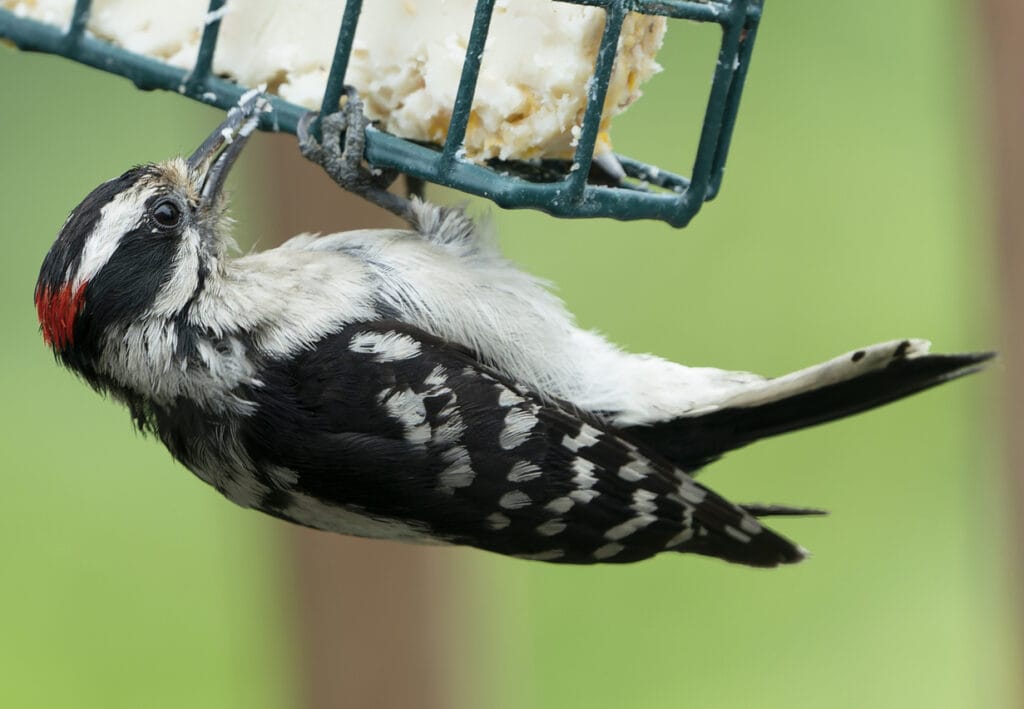
- Scientific name: Dryobates Pubescens
- Length: 5.5-6.7 inches
- Weight: 0.7-1.0 ounces
- Wingspan: 9.8-11.8 inches
Downy Woodpeckers are commonly seen in most parks, forests, and backyard feeders in the United States.
Those woodpeckers are slightly smaller than most other woodpeckers; even smaller than a robin.
Downy Woodpeckers have a black and white color pattern all over their bodies. Both the belly and the back are white, while the wings and tails are black with white stripes.
The crown is a pattern of white and black lines with a small red patch on the back of the head. That red patch is only found in males and it’s the most helpful sign to distinguish between both genders.
Whether you live in Pennsylvania or any of the eastern or northern states, you can spot the Downy Woodpecker in any forest around you. Downy Woodpeckers live and breed in almost all of the United States all year long.
In most scenarios, you’d often find Downy Woodpeckers latching to the barks of trees where they seek their food. They form their nests in the cavities of trees and then come out on the bark and branches to find their meal.
Top Tip: Downy Woodpeckers feed mainly on insects and small larvae found in plants. While searching for food, they move horizontally around the trunk of the tree faster than the average woodpecker.
Downy Woodpeckers have a beautiful call that consists of rapid, high-pitched noises. They often mix the call with some drumming to communicate with nearby woodpeckers.
In winter, Downy Woodpeckers like to mix with flocks of other birds that have the same size. This reduces the chance of a predator attack and makes finding food a lot easier.
4. Hairy Woodpecker
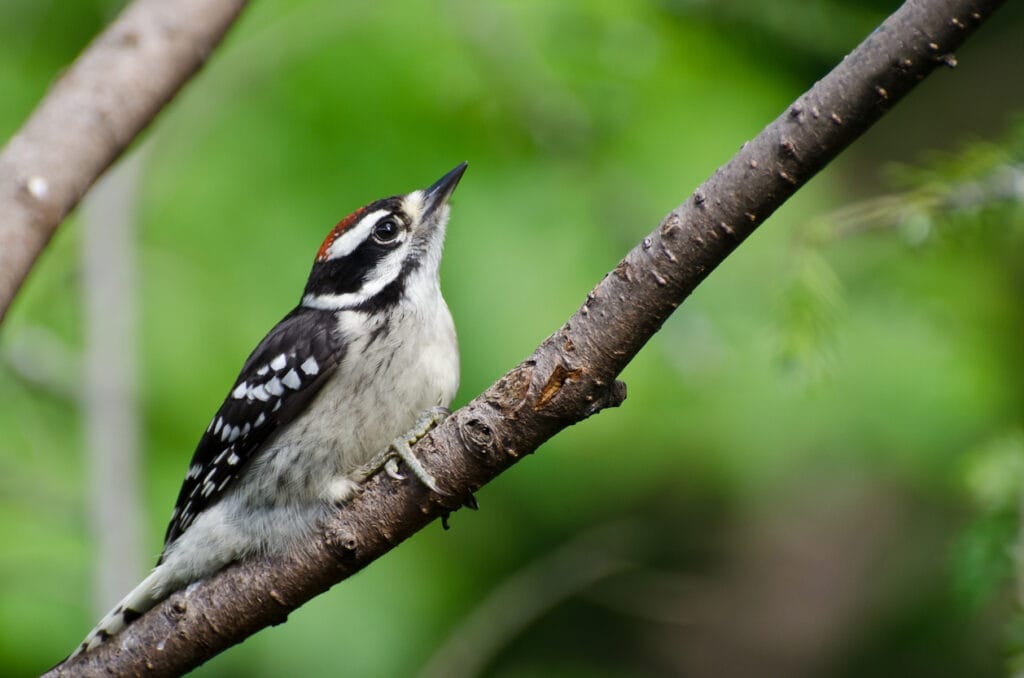
- Scientific name: Dryobates Villosus
- Length: 7.1-10.2 inches
- Weight: 1.4-3.4 ounces
- Wingspan: 13.0-16.1 inches
One of the most difficult challenges while identifying woodpeckers is differentiating between Hairy Woodpeckers and Downy Woodpeckers.
From a distance, both birds look almost identical. If your eyes aren’t trained enough, you won’t notice that Downy Woodpeckers are two-thirds of the size of Hairy Woodpeckers.
The color pattern is almost the same as well. The same black and white patterns on the belly, back, and wings. Even the male-identifying red patch is also present on the back of Hairy Woodpecker males.
Along with the bigger size, Hairy Woodpeckers have a couple of additional identifying features. Their backs aren’t as curved as Downy Woodpeckers, but more of a straight, soldier-like back. Also, the bill is longer and sharper than Downy Woodpeckers.
Roughly, you can find Hairy Woodpeckers anywhere you’d find Downy Woodpeckers. They live and breed in almost all of the United States. In Pennsylvania, you can find them nesting in tree cavities where they breed and sleep.
Once awake, Hairy Woodpeckers latch onto the bark of the trees in search of food. Over 70% of their diet consists of insects, especially bark beetles and ants.
As for the calls of Hairy Woodpeckers, you guessed it, it sounds almost exactly like Downy’s Woodpeckers. They make the same rapid chirps followed by fast drumming.
Across America, Hairy Woodpeckers can nest anywhere from sea level to high in the mountains. The oldest recorded Hairy Woodpecker was a 15-year-old male who was captured and re-released in 2010 in New York.
5. Red-bellied Woodpecker
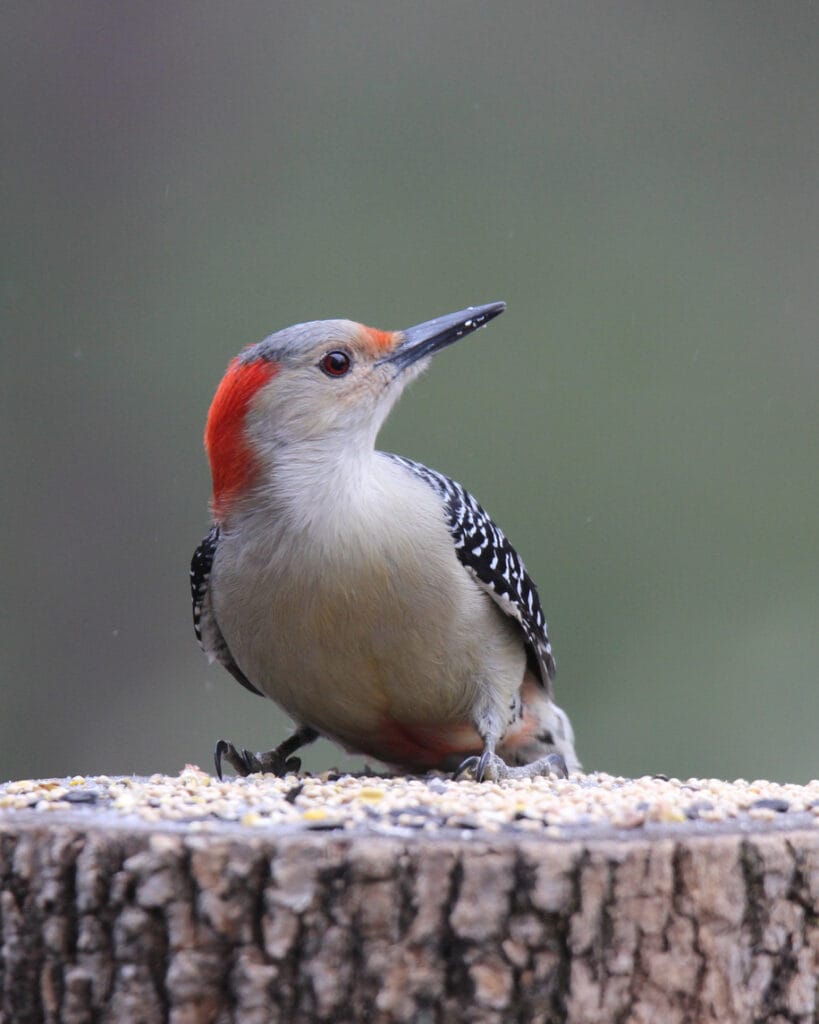
- Scientific name: Melanerpes Carolinus
- Length: 9.2-9.4 inches
- Weight: 2.0-3.2 ounces
- Wingspan: 13.0-16.5 inches
If you haven’t seen a picture of a Red-bellied Woodpecker before, you’ll hardly identify it in real life. That’s because Red-bellied Woodpeckers hardly have a red belly!
Instead, they have a red line extending from the middle of their eyes to their napes. The cheeks and chin have an orange hue that’s very close in color to the red line.
Top Tip: The same orange hue is distributed in pale patches all over a white belly. The back and wings have bold black and white stripes that continue till they reach the tail.
Unlike most woodpeckers on our list, Red-bellied Woodpeckers can’t be found all over the United States. Instead, they live and breed in the eastern States all year long.
Red-bellied Woodpeckers’ habitat in Pennsylvania is similar to most Woodpeckers. They form their nests inside the cavities of trees and seek their food on the bark of trees.
Red-bellied Woodpeckers prefer insects as their main source of food. They also eat plant-material like seeds, nuts, and acorns.
The calling of the Red-bellied Woodpecker isn’t one you hear every day. It’s composed of three consecutive slow chirps with one second of silence in between.
Red-bellied Woodpeckers have an exceptionally stretchy tongue. They can stick their tongues out two inches past their bills.
That long tongue is covered with sticky saliva. This allows the Red-bellied Woodpecker to snatch the insect from deep inside the tree bark.
6. Pileated Woodpecker

- Scientific name: Dryocopus Pileatus
- Length: 15.8-19.3 inches
- Weight: 8.8-12.3 ounces
- Wingspan: 26.0-29.5 inches
The Pileated Woodpecker is the largest bird on our list today and also one of the biggest in the entirety of North America. This striking bird is around the same length as the American Crow!
Pileated Woodpeckers have black as their main body color. There’s a white line starting under the eye which extends to a large area under the wings. Both the throat and the bill of the bird are black.
A distinctive red crest on the head is often how Pileated Woodpeckers are identified from a distance. The males have an additional red patch on their cheeks just behind their bills.
Pileated Woodpeckers can be found any time of the year in Pennsylvania. They live and breed in most of the eastern American States.
Pileated Woodpeckers seem to have a preference for dead or dying trees. If you have some of these in your backyard, consider leaving them as they may attract a breeding pair of Pileated Woodpeckers.
Like most woodpeckers, Pileated Woodpeckers dig holes in trees to look for food. However, these particular woodpeckers dig characteristic rectangular holes in the trees. That’s how they hunt for their favorite meal; ants.
Pileated woodpecker calls are short, interrupted chirps that sound like: “wak wak wak.” There’s no particular pattern and the bird seems to keep chirping until it feels like it wants to stop.
A pair of Pileated Woodpeckers would stay together most of their lives. They often defend their territory aggressively all year. However, they may tolerate new birds in winter should they not seem to be aggressive.
7. Yellow-bellied Sapsucker

- Scientific name: Sphyrapicus Varius
- Length: 7.1-8.7 inches
- Weight: 1.5-1.9 ounces
- Wingspan: 13.4-15.8 inches
If you manage to spot some uniform holes drilled around a tree, you may have a Yellow-bellied Sapsucker nearby.
Yellow-bellied Sapsuckers are small, robin-sized woodpeckers that have a black and white color pattern. The pattern is quite similar to the Downy and Hairy Woodpeckers, but the Yellow-bellied Sapsuckers have red crests.
The males are distinguished from the females with their red throats.
Yellow-bellied Sapsuckers are the only woodpeckers on our list that aren’t present all year round in Pennsylvania. Instead, they pick the state as one of their breeding grounds and then migrate towards the central states.
Author Note: Like most woodpeckers, Yellow-bellied Sapsuckers are bark foragers. They latch to the bark of trees looking for food that consists mainly of insects.
They also like to dig holes deep enough in the trees called “sap wells.” The woodpeckers would then push their tongues and suck the tree sap. That’s how they got the name “Sap Suckers.”
Once you hear the Yellow-bellied Sapsucker’s calls, they’ll stick in your mind forever. Have you ever heard a bird that goes: “pew pew pew pew?” Now you have.
That’s All for Now
Those were the seven different types of woodpeckers in Pennsylvania.
Since most of these woodpeckers love to nest on trees, there’s a good chance you might see them in your backyard or a nearby park.
Just make sure to keep a fair distance. Many woodpeckers are territorial and they aren’t afraid to attack should they feel threatened.
Keep them safe, and stay safe yourself!
FAQ
To find out where recent sightings of woodpecker have been, try eBird. You can search for the latest sightings or particular species or what has been seen in a certain area.
Middle Creek Wildlife Management Area, Bald Eagle State Park, Peace Valley Park, Yellow Creek State Park and Susquehanna River Birding & Wildlife Trail are a good place to start for Pileated Woodpecker.
Yellow-bellied Sapsuckers are the most common species in Pennsylvania, particularly in the north of the state.




